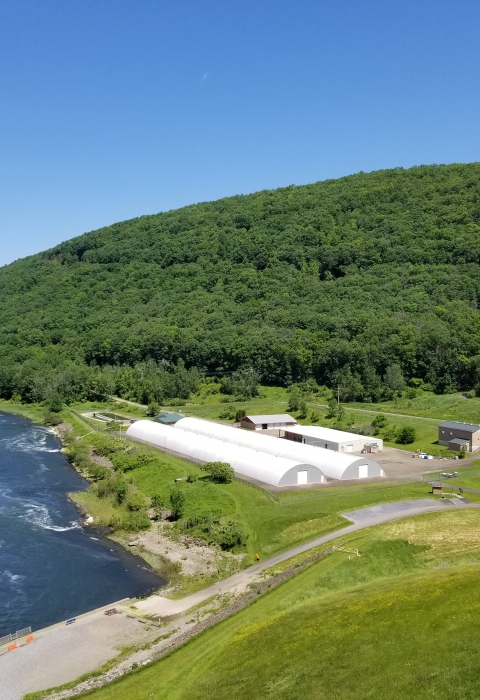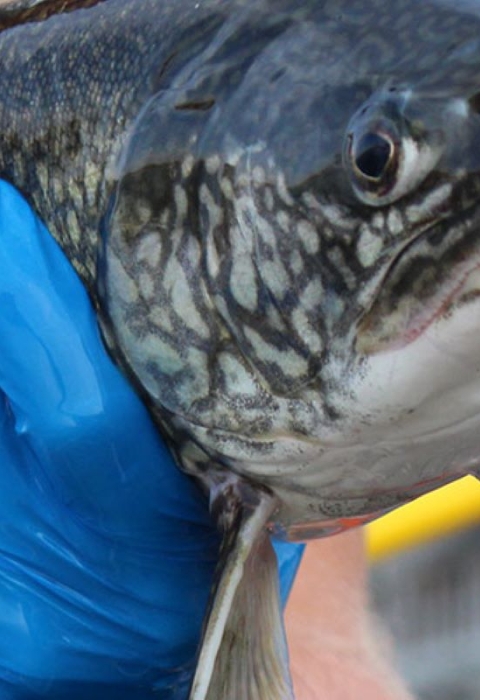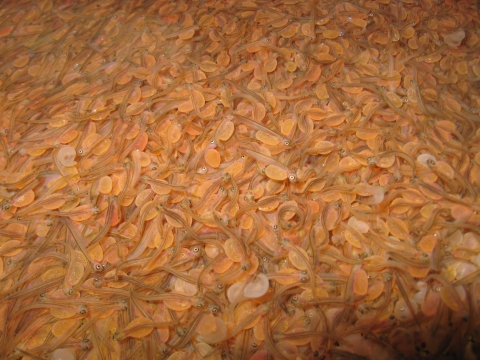Featured Species
Lake Trout
Currently, the hatchery produces lake trout (Salvelinus namaycush) and bloaters (Coregonus hoyi). Lake trout are produced for Lake Erie and Ontario. The bloaters are only produced for Lake Ontario. Both species were once robust in their respective environments. Due to overfishing and predation from non-native sea lamprey drastically reduced lake trout stocks. The bloater’s decline was associated with the invasion of Alewives and Rainbow Smelt in the great lakes from the passing through of the welland canal to bypass the Niagara Falls, as well as sea lamprey predation and pollution.
Lake Trout (Salvelinus namaycush) are a cold-water fish and are the largest of the trout species. Typically, lake trout will inhabit depths greater than 50 feet, but have been found in over 200 feet as well. Native to the northeast United States and Canada, this deep-water fish was once a top predator fish in the Great Lakes and historically had a high value as a commercial and recreational fishery. Lake trout have ecological importance as natural population control for native and introduced bait and forage fish, keeping their numbers at stable levels and creating a healthy balance on the food web of the lake. Lake trout populations crashed in the Great Lakes as a result of overfishing, water pollution, and predation by invasive sea lamprey.
The focus of the multi-state, federal, and Canadian effort to restore lake trout to the Great Lakes is to increase the numbers of adult spawning fish to a level that will support a self-sustaining population and a robust angler harvest. Recent successful efforts have created a lake environment capable of supporting self-sustaining lake trout populations.
The life cycle of lake trout starts during the fall months, when the fish start to spawn. They spawn over boulder beds and do not dig nests. The early males that arrive will clear away debris on the beds. Spawning can take the whole bed where males and females may create spawning groups and will spawn many times over the next several days or weeks. The fertilized eggs will sink to the bottom into the small crevices of the rocks where water current keeps the eggs silt free. A single female can lay 2,000 to 20,000 eggs depending on her size. The eggs will develop and hatch around February and March. They will hang around the beds while they continue to develop fins. Then they will disperse across the lake and inhabit a variety of habitats, where they start the search for zooplankton and try to avoid predation.
Fun fact: The New York State record lake trout was caught off Dunkirk NY in 2003. The fish weighed 41.5 pounds and measured 42.5 inches. Because the fish was tagged, we can trace the fish back to an Allegheny National Fish Hatchery stocking event in 1985, meaning it was more than 18 years old. It is not unheard of to find 50-year-old lake trout swimming in the Great Lakes. A possible world record lake trout was recently caught in Colorado, weighing in at 73.29 pounds and a length of 47 inches and an astonishing 37-inch girth.
Bloaters
Bloater (Coregonus hoyi) and Cisco (Coregonus artedi) once played critical roles in the trophic energy and nutrient dynamics of the Great Lakes, as prey food for top predatory fish. Bloater was once the primary prey for Lake Trout in the deep waters of the Great Lakes. By the 1950’s, however, overfishing and competition with other plankton-eating, non-native fishes (Alewife and Rainbow Smelt) caused the collapse of the Bloaters and Ciscoes, which then contributed to the collapse of the Lake Trout fishery. Lake Trout (and landlocked Atlantic Salmon) have been plagued by a thiamin vitamin deficiency resulting from eating the Alewife that contain an enzyme called thiaminase that breaks down thiamin. Thiamin plays a critical role in energy metabolism, and therefore in the growth, development, and function of cells. The syndrome is called thiaminase-based early mortality. As Lake Trout feed on Alewife, their eggs become deficient in thiamin, which leads to a failure of fertilized eggs to hatch, or failure of fry to survive. Bloater do not contain thiaminase and therefore do not contribute to thiaminase-based early mortality when consumed by Lake Trout.
Natural recovery of depleted coregonid fish stocks in Lake Ontario is unlikely given the severely low abundances and scattered population density. Captive propagation in hatcheries and restoration stocking, therefore, is required. The Service is developing rearing capacity at the ANFH, and at the Service’s Northeast Fishery Center (NEFC) to achieve initial stocking goals of 500,000 Bloater. Additionally, the Service will explore developing a hatchery brood stock line for future egg production, culture, and stocking of Bloater.
Currently, most Bloater eggs are available only from wild-caught adult fish living in the upper Great Lakes. These fish spawn in the early winter at depths greater than 300 feet, making it difficult to obtain adequate numbers on eggs for aquaculture restoration programs. The U.S. Fish and Wildlife Service is exploring broodstock broodstock
The reproductively mature adults in a population that breed (or spawn) and produce more individuals (offspring or progeny).
Learn more about broodstock development and will manipulate light conditions and water temperatures to simulate conditions observed in the Bloater’s natural lake environment. This will entice adult fish to spawn in the hatchery system, allowing the service to obtain adequate numbers of fertilized eggs without the need to send crews out on the harsh, deep waters of the Great Lakes in winter to collect eggs from wild caught fish.


